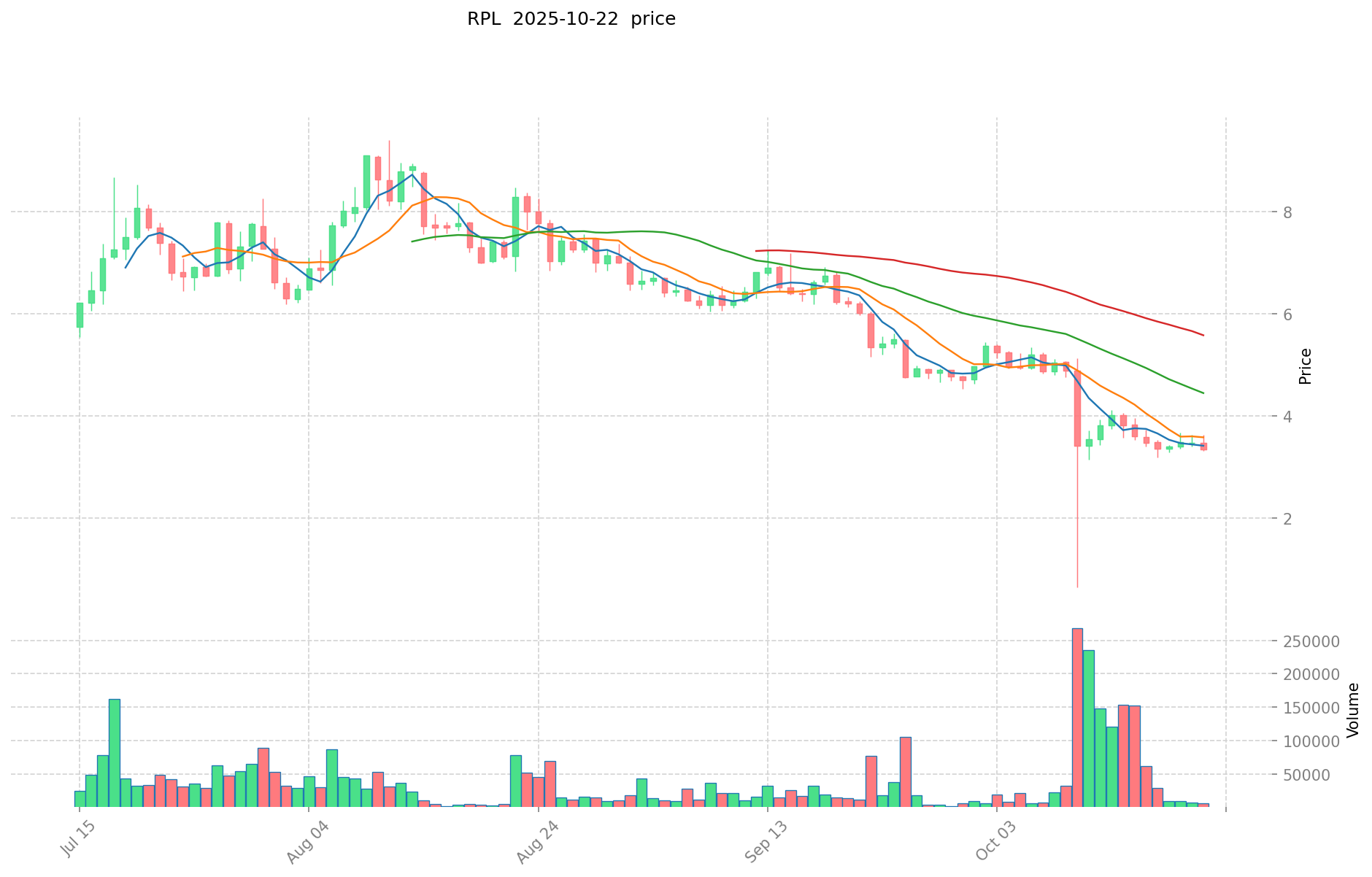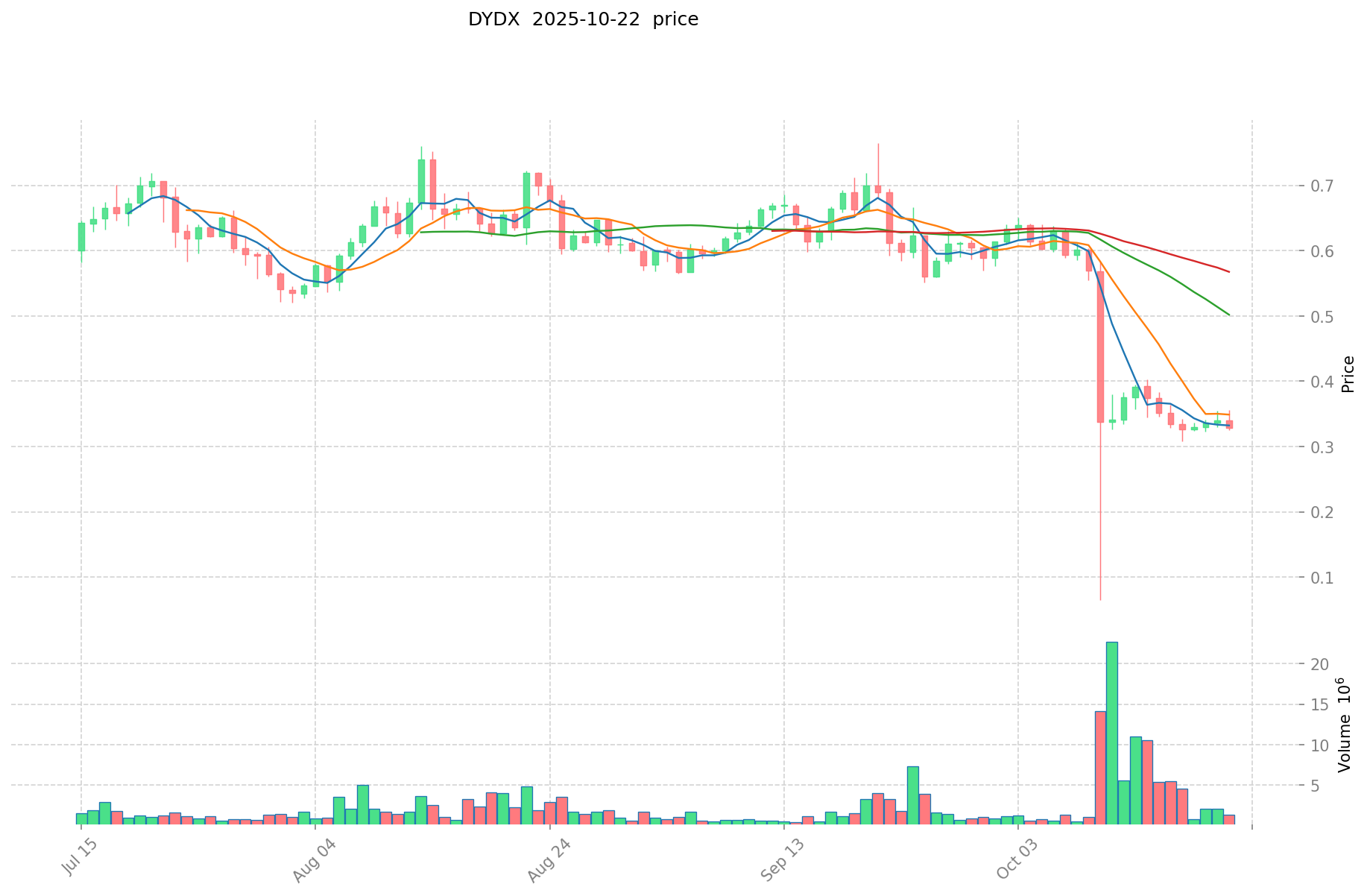RPL vs DYDX: Comparing Two Leading DeFi Tokens in the Ethereum Ecosystem
Introduction: RPL vs DYDX Investment Comparison
In the cryptocurrency market, the comparison between Rocket Pool (RPL) and dYdX (DYDX) has been an unavoidable topic for investors. The two not only show significant differences in market cap ranking, application scenarios, and price performance, but also represent different positions in the crypto asset landscape.
Rocket Pool (RPL): Since its launch, it has gained market recognition for its Ethereum PoS infrastructure service.
dYdX (DYDX): It has been hailed as a decentralized derivatives trading protocol since its inception, and is one of the most traded cryptocurrencies globally.
This article will comprehensively analyze the investment value comparison between RPL and DYDX, focusing on historical price trends, supply mechanisms, institutional adoption, technological ecosystems, and future predictions, attempting to answer the question most concerning to investors:
"Which is the better buy right now?"
I. Price History Comparison and Current Market Status
Rocket Pool (RPL) and dYdX (DYDX) Historical Price Trends
- 2023: RPL reached an all-time high of $61.9 on April 17, 2023.
- 2024: DYDX hit its all-time high of $4.52 on March 8, 2024.
- Comparative analysis: In the recent market cycle, RPL has fallen from its peak of $61.9 to the current price of $3.35, while DYDX has declined from $4.52 to $0.3281.
Current Market Situation (2025-10-22)
- RPL current price: $3.35
- DYDX current price: $0.3281
- 24-hour trading volume: RPL $22,627.57 vs DYDX $440,004.80
- Market Sentiment Index (Fear & Greed Index): 34 (Fear)
Click to view real-time prices:
- View RPL current price Market Price
- View DYDX current price Market Price


Investment Value Analysis: RPL vs DYDX
I. Core Factors Influencing RPL vs DYDX Investment Value
Supply Mechanism Comparison (Tokenomics)
- RPL: RPL is associated with the Ethereum liquid staking derivative (LSD) sector, appearing as a representative token in this market segment
- DYDX: DYDX operates on a model described as "capturing all secondary market participants" according to market analysis
- 📌 Historical Pattern: Supply mechanisms drive price cycles through trading volume and market interest in respective protocols
Institutional Adoption and Market Applications
- Institutional Holdings: Limited information available from provided sources
- Enterprise Adoption: RPL has gained visibility through listings on major exchanges like Binance, positioning it as a representative in the LSD market segment
- Regulatory Stance: Limited information available from provided sources
Technical Development and Ecosystem Building
- RPL Technical Development: Connected to Ethereum's staking ecosystem with focus on liquid staking derivatives
- DYDX Technical Development: Focused on decentralized trading platform functionality
- Ecosystem Comparison: RPL appears to be primarily involved in liquidity provision and staking within the Ethereum ecosystem, while DYDX focuses on decentralized exchange functionality
Macroeconomic Factors and Market Cycles
- Performance in Inflationary Environments: Limited information available from provided sources
- Macro Monetary Policy Impact: Both tokens are subject to general crypto market trends including risk assessment based on the "expected return/volatility" formula mentioned in trading discussions
- Geopolitical Factors: Limited information available from provided sources III. 2025-2030 Price Prediction: RPL vs DYDX
Short-term Prediction (2025)
- RPL: Conservative $2.4455 - $3.35 | Optimistic $3.35 - $4.891
- DYDX: Conservative $0.187701 - $0.3293 | Optimistic $0.3293 - $0.46102
Mid-term Prediction (2027)
- RPL may enter a growth phase, with estimated prices ranging from $3.34048935 to $5.1852372
- DYDX may enter a growth phase, with estimated prices ranging from $0.277757964 to $0.56814129
- Key drivers: Institutional capital inflow, ETFs, ecosystem development
Long-term Prediction (2030)
- RPL: Base scenario $3.3949667483325 - $6.286975459875 | Optimistic scenario $6.286975459875 - $7.73297981564625
- DYDX: Base scenario $0.378802300120481 - $0.642037796814375 | Optimistic scenario $0.642037796814375 - $0.918114049444556
Disclaimer: These predictions are based on historical data and market analysis. Cryptocurrency markets are highly volatile and subject to change. This information should not be considered as financial advice. Always conduct your own research before making investment decisions.
RPL:
| 年份 | 预测最高价 | 预测平均价格 | 预测最低价 | 涨跌幅 |
|---|---|---|---|---|
| 2025 | 4.891 | 3.35 | 2.4455 | 0 |
| 2026 | 5.85111 | 4.1205 | 3.46122 | 23 |
| 2027 | 5.1852372 | 4.985805 | 3.34048935 | 48 |
| 2028 | 5.848349265 | 5.0855211 | 3.661575192 | 51 |
| 2029 | 7.10701573725 | 5.4669351825 | 5.302927127025 | 63 |
| 2030 | 7.73297981564625 | 6.286975459875 | 3.3949667483325 | 87 |
DYDX:
| 年份 | 预测最高价 | 预测平均价格 | 预测最低价 | 涨跌幅 |
|---|---|---|---|---|
| 2025 | 0.46102 | 0.3293 | 0.187701 | 0 |
| 2026 | 0.4465308 | 0.39516 | 0.3595956 | 20 |
| 2027 | 0.56814129 | 0.4208454 | 0.277757964 | 28 |
| 2028 | 0.59833694745 | 0.494493345 | 0.30164094045 | 50 |
| 2029 | 0.73766044740375 | 0.546415146225 | 0.46445287429125 | 66 |
| 2030 | 0.918114049444556 | 0.642037796814375 | 0.378802300120481 | 95 |
IV. Investment Strategy Comparison: RPL vs DYDX
Long-term vs Short-term Investment Strategies
- RPL: Suitable for investors focused on Ethereum staking ecosystem and liquid staking derivatives
- DYDX: Suitable for investors interested in decentralized derivatives trading platforms
Risk Management and Asset Allocation
- Conservative investors: RPL: 40% vs DYDX: 60%
- Aggressive investors: RPL: 60% vs DYDX: 40%
- Hedging tools: Stablecoin allocation, options, cross-currency portfolios
V. Potential Risk Comparison
Market Risks
- RPL: Highly dependent on Ethereum's performance and adoption of liquid staking
- DYDX: Susceptible to volatility in the derivatives trading market
Technical Risks
- RPL: Scalability, network stability of Ethereum
- DYDX: Platform security, smart contract vulnerabilities
Regulatory Risks
- Global regulatory policies may impact both tokens differently, with potential greater scrutiny on derivatives platforms like DYDX
VI. Conclusion: Which Is the Better Buy?
📌 Investment Value Summary:
- RPL advantages: Strong position in Ethereum's liquid staking derivative sector
- DYDX advantages: Established presence in decentralized derivatives trading
✅ Investment Advice:
- New investors: Consider a balanced approach, leaning towards RPL for its connection to Ethereum's core infrastructure
- Experienced investors: Evaluate based on personal risk tolerance and market outlook for each sector
- Institutional investors: Consider both for diversification, with allocation based on market analysis and regulatory developments
⚠️ Risk Warning: The cryptocurrency market is highly volatile. This article does not constitute investment advice. None
FAQ
Q1: What are the main differences between RPL and DYDX? A: RPL is associated with Ethereum's liquid staking derivative sector, while DYDX operates as a decentralized derivatives trading protocol. RPL focuses on Ethereum PoS infrastructure services, whereas DYDX is known for its decentralized exchange functionality.
Q2: How do the current prices of RPL and DYDX compare to their all-time highs? A: As of 2025-10-22, RPL is trading at $3.35, down from its all-time high of $61.9 on April 17, 2023. DYDX is trading at $0.3281, down from its all-time high of $4.52 on March 8, 2024.
Q3: What are the short-term price predictions for RPL and DYDX in 2025? A: For RPL, the conservative estimate is $2.4455 - $3.35, and the optimistic estimate is $3.35 - $4.891. For DYDX, the conservative estimate is $0.187701 - $0.3293, and the optimistic estimate is $0.3293 - $0.46102.
Q4: How do the long-term predictions for RPL and DYDX compare in 2030? A: For RPL, the base scenario is $3.3949667483325 - $6.286975459875, with an optimistic scenario of $6.286975459875 - $7.73297981564625. For DYDX, the base scenario is $0.378802300120481 - $0.642037796814375, with an optimistic scenario of $0.642037796814375 - $0.918114049444556.
Q5: What are the main risk factors for investing in RPL and DYDX? A: For RPL, risks include dependency on Ethereum's performance and adoption of liquid staking. For DYDX, risks involve volatility in the derivatives trading market. Both face potential regulatory risks, with DYDX possibly facing greater scrutiny due to its focus on derivatives trading.
Q6: How might conservative and aggressive investors allocate their investments between RPL and DYDX? A: Conservative investors might consider allocating 40% to RPL and 60% to DYDX, while aggressive investors might allocate 60% to RPL and 40% to DYDX. However, these allocations should be adjusted based on individual risk tolerance and market analysis.
Share
Content